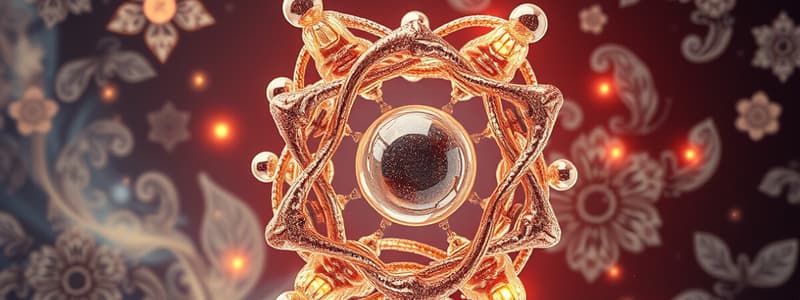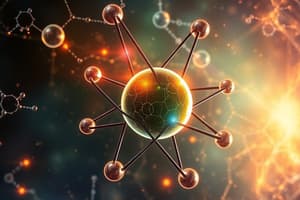Podcast
Questions and Answers
The atomic number of an element is determined by the number of neutrons in its nucleus.
The atomic number of an element is determined by the number of neutrons in its nucleus.
False (B)
Ionic bonds are formed when atoms share electrons.
Ionic bonds are formed when atoms share electrons.
False (B)
Bases typically have a bitter taste and a slippery feel.
Bases typically have a bitter taste and a slippery feel.
True (A)
The pH scale ranges from 0 to 14, with values lower than 7 indicating a basic solution.
The pH scale ranges from 0 to 14, with values lower than 7 indicating a basic solution.
Synthesis reactions involve the breakdown of a single compound into two or more products.
Synthesis reactions involve the breakdown of a single compound into two or more products.
The mass number of an atom is the total count of protons and electrons in its nucleus.
The mass number of an atom is the total count of protons and electrons in its nucleus.
Metalloids possess properties that are intermediate between metals and nonmetals.
Metalloids possess properties that are intermediate between metals and nonmetals.
According to the first law of thermodynamics, energy can be created and destroyed.
According to the first law of thermodynamics, energy can be created and destroyed.
Study Notes
Fundamental Concepts
- Matter: Anything that has mass and occupies space. Exists in three states: solid, liquid, gas.
- Atoms: Basic units of matter, consisting of protons, neutrons, and electrons.
- Elements: Pure substances made of only one type of atom (e.g., hydrogen, oxygen).
Atomic Structure
- Nucleus: Center of the atom, contains protons (+) and neutrons (neutral).
- Electrons (-): Orbit the nucleus in energy levels or shells.
- Atomic Number: Number of protons in the nucleus; defines the element.
- Mass Number: Total number of protons and neutrons.
Chemical Bonds
- Ionic Bonds: Formed when electrons are transferred between atoms, resulting in charged ions.
- Covalent Bonds: Formed when atoms share electrons.
- Metallic Bonds: Characterized by the sharing of electrons among a lattice of metal atoms.
Chemical Reactions
- Reactants: Substances that undergo a change in a reaction.
- Products: New substances formed as a result of a chemical reaction.
- Types of Reactions:
- Synthesis: Two or more substances combine to form a new compound.
- Decomposition: A single compound breaks down into two or more products.
- Single Replacement: An element replaces another in a compound.
- Double Replacement: Components of two compounds exchange places.
The Periodic Table
- Groups/Families: Vertical columns, elements with similar properties.
- Periods: Horizontal rows, represent increasing atomic number.
- Metals, Nonmetals, Metalloids: Categories based on physical and chemical properties.
Acids and Bases
- Acids: Substances that donate protons (H+) in a solution; often have a sour taste.
- Bases: Substances that accept protons; often have a bitter taste and slippery feel.
- pH Scale: Measures the acidity or basicity of a solution; ranges from 0 (acidic) to 14 (basic).
Thermodynamics
- First Law: Energy cannot be created or destroyed, only transformed.
- Second Law: Entropy of an isolated system always increases over time.
- Enthalpy (ΔH): Heat content of a system at constant pressure.
Stoichiometry
- Mole Concept: A mole is 6.022 × 10²³ particles (Avogadro's number).
- Balanced Equations: Must have the same number of each type of atom on both sides.
Organic Chemistry
- Hydrocarbons: Compounds consisting solely of hydrogen and carbon.
- Functional Groups: Specific groups of atoms that determine the characteristics of organic compounds (e.g., -OH, -COOH).
Inorganic Chemistry
- Salts: Formed from the neutralization of an acid and a base.
- Coordination Compounds: Consist of a central metal atom bonded to surrounding ligands.
Laboratory Techniques
- Titration: Method to determine the concentration of a solution by reacting it with a standard solution.
- Chromatography: Technique for separating mixtures based on their movement through a stationary phase.
Safety and Ethics
- Laboratory Safety: Importance of personal protective equipment (PPE) and following safety protocols.
- Ethical Research: Adherence to ethical standards in conducting experiments and reporting results.
Fundamental Concepts
- Matter is defined as anything possessing mass and occupying space, existing in three states: solid, liquid, and gas.
- Atoms are the basic units of matter, comprised of subatomic particles: protons (positively charged), neutrons (neutral), and electrons (negatively charged).
- Elements are pure substances made entirely of one type of atom, such as hydrogen or oxygen.
Atomic Structure
- The nucleus is the atom's core, housing protons and neutrons.
- Electrons are found in energy levels, or shells, orbiting around the nucleus.
- The atomic number identifies an element and is equal to the number of protons in its nucleus.
- The mass number represents the total count of protons and neutrons in an atom.
Chemical Bonds
- Ionic bonds occur when electrons are transferred between atoms, resulting in the formation of charged ions.
- Covalent bonds are created when atoms share electrons.
- Metallic bonds involve the pooling of electrons among a lattice of metal atoms, contributing to electrical conductivity.
Chemical Reactions
- Reactants are the starting substances that undergo change during a chemical reaction.
- Products are the new substances formed as a result of the chemical reaction.
- Types of reactions include:
- Synthesis: Combining two or more substances to create a new compound.
- Decomposition: Breaking a single compound into two or more simpler products.
- Single Replacement: An element takes the place of another in a compound.
- Double Replacement: Elements from two compounds swap places.
The Periodic Table
- Groups or families are vertical columns containing elements with similar chemical properties.
- Periods are horizontal rows that indicate increasing atomic number from left to right.
- Elements are categorized as metals, nonmetals, or metalloids based on their physical and chemical properties.
Acids and Bases
- Acids are substances that donate protons (H+) in solutions and typically have a sour taste.
- Bases accept protons and usually exhibit a bitter taste with a slippery feel.
- The pH scale quantifies acidity and basicity, ranging from 0 (strongly acidic) to 14 (strongly basic), with 7 being neutral.
Thermodynamics
- The First Law of Thermodynamics states that energy can neither be created nor destroyed, only changed from one form to another.
- The Second Law of Thermodynamics asserts that the entropy of an isolated system tends to increase over time.
- Enthalpy, represented as ΔH, indicates the heat content of a system at a constant pressure.
Stoichiometry
- The mole concept defines a mole as 6.022 × 10²³ particles, known as Avogadro's number.
- Balanced equations must ensure that the same number of each type of atom appears on both sides of the reaction.
Organic Chemistry
- Hydrocarbons are compounds consisting entirely of hydrogen and carbon atoms.
- Functional groups, such as -OH and -COOH, are specific atom groups that influence the traits and reactivity of organic compounds.
Inorganic Chemistry
- Salts are formed through the neutralization reaction between an acid and a base.
- Coordination compounds consist of a central metal atom bonded to various surrounding ligands.
Laboratory Techniques
- Titration is a method used to ascertain the concentration of a solution by reacting it with a standard solution.
- Chromatography is a technique for separating mixtures based on the different rates at which their components move through a stationary phase.
Safety and Ethics
- Laboratory safety emphasizes the necessity of personal protective equipment (PPE) and adherence to safety protocols to prevent accidents.
- Ethical research involves complying with ethical standards in experimental methods and the accurate reporting of results.
Studying That Suits You
Use AI to generate personalized quizzes and flashcards to suit your learning preferences.
Description
Test your knowledge on the fundamental concepts of chemistry, including matter, atomic structure, chemical bonds, and chemical reactions. This quiz covers the basics of atoms, elements, and the interactions that form compounds. Embrace the challenge and see how well you understand these essential principles!




